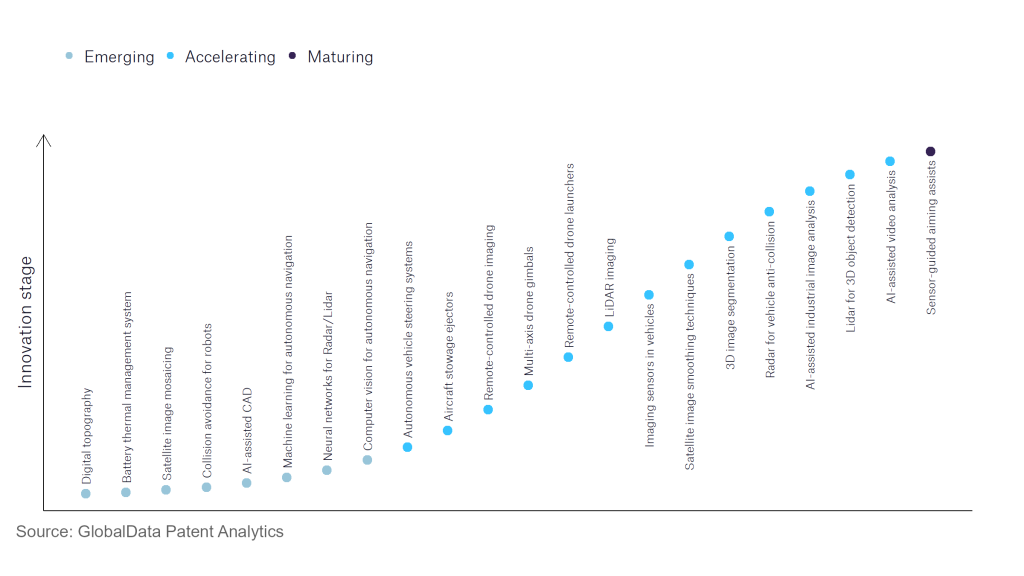The aerospace and defence industry continues to be a hotbed of innovation, with activity driven by developments in artificial technology and machine learning, and growing importance of technologies such as drones, satellite technology and big data. In the last three years alone, there have been over 174,000 patents filed and granted in the aerospace and defence industry, according to GlobalData’s report on Artificial Intelligence in Aerospace, Defence & Security: Neural networks for Radar/Lidar. Buy the report here.
However, not all innovations are equal and nor do they follow a constant upward trend. Instead, their evolution takes the form of an S-shaped curve that reflects their typical lifecycle from early emergence to accelerating adoption, before finally stabilising and reaching maturity.
Identifying where a particular innovation is on this journey, especially those that are in the emerging and accelerating stages, is essential for understanding their current level of adoption and the likely future trajectory and impact they will have.
180+ innovations will shape the aerospace and defence industry
According to GlobalData’s Technology Foresights, which plots the S-curve for the aerospace and defence industry using innovation intensity models built on over 262,000 patents, there are 180+ innovation areas that will shape the future of the industry.
Within the emerging innovation stage, machine learning for autonomous navigation, battery thermal management system, and satellite image mosaicing are disruptive technologies that are in the early stages of application and should be tracked closely. 3D image segmentation, AV on-board control systems, and lidar for 3D object detection are some of the accelerating innovation areas, where adoption has been steadily increasing. Among maturing innovation areas is sensor-guided aiming assists, which is now well established in the industry.
Innovation S-curve for artificial intelligence in the aerospace and defence industry

Neural networks for radar/LiDAR is a key innovation area in artificial intelligence
Neural networks model the neurons in a biological brain and create a system for pattern detection. Similarly, radar/LiDAR can draw from a database of previous radar/LiDAR detections and sort an object into a specific category.
GlobalData’s analysis also uncovers the companies at the forefront of each innovation area and assesses the potential reach and impact of their patenting activity across different applications and geographies. According to GlobalData, there are 10+ companies, spanning technology vendors, established aerospace and defence companies, and up-and-coming start-ups engaged in the development and application of neural networks for radar/LiDAR.
Key players in neural networks for radar/LiDAR – a disruptive innovation in the aerospace and defence industry
‘Application diversity’ measures the number of different applications identified for each relevant patent and broadly splits companies into either ‘niche’ or ‘diversified’ innovators.
‘Geographic reach’ refers to the number of different countries each relevant patent is registered in and reflects the breadth of geographic application intended, ranging from ‘global’ to ‘local’.
Patent volumes related to neural networks for Radar/LiDAR
| Company | Total patents (2021 - 2023) | Premium intelligence on the world's largest companies |
| Ford Motor | 29 | Unlock Company Profile |
| Aptiv | 20 | Unlock Company Profile |
| Luminar Technologies | 19 | Unlock Company Profile |
| Amazon.com | 18 | Unlock Company Profile |
| Qualcomm | 17 | Unlock Company Profile |
| NVIDIA | 11 | Unlock Company Profile |
| Huawei Investment & Holding | 8 | Unlock Company Profile |
| Seoul Robotics | 8 | Unlock Company Profile |
| Samsung Group | 7 | Unlock Company Profile |
| Sony Group | 7 | Unlock Company Profile |
| Stradvision | 7 | Unlock Company Profile |
| Alphabet | 5 | Unlock Company Profile |
| Uatc | 5 | Unlock Company Profile |
| Metawave | 5 | Unlock Company Profile |
| Siemens | 5 | Unlock Company Profile |
| E.C. Motors | 5 | Unlock Company Profile |
| Chongqing Jinkang New Energy Vehicle | 5 | Unlock Company Profile |
Source: GlobalData Patent Analytics
Ford Motor is one of the leading patent filers in neural network for radar-LiDAR. The patents are filed in an effort to develop autonomous driving capabilities, utilising artificial intelligence (AI) and machine learning, to develop more advanced vehicles. The company also uses neural networks for industrial applications, utilising them for quality assurance methods. China Ford Motor works with Baidu to implement AI technology and expand in the market. Aptiv is a technology company, which is attempting to enhance automated vehicles and create safer technology. It is combining radar solutions with neural networks to provide industry solutions.
Some other key patent filers in the industry include Luminar Technologies, Amazon, Qualcomm, and NVIDIA.
Some other significant companies in terms of application diversity include Chongqing Jinkang New Energy Vehicle, E.C. Motors and Stradvision. In terms of geographic reach, Stradvision is at the top, followed by Samsung and Qualcomm.
The industry is advancing significantly in both the commercial and military sector. With AI solutions being developed to create greater safety and autonomy, the industry is likely to see greater integration of this technology in coming years.
To further understand how artificial intelligence is disrupting the aerospace and defence industry, access GlobalData’s latest thematic research report on Thematic Research: AI in Defense.
Data Insights
From

The gold standard of business intelligence.
Blending expert knowledge with cutting-edge technology, GlobalData’s unrivalled proprietary data will enable you to decode what’s happening in your market. You can make better informed decisions and gain a future-proof advantage over your competitors.



